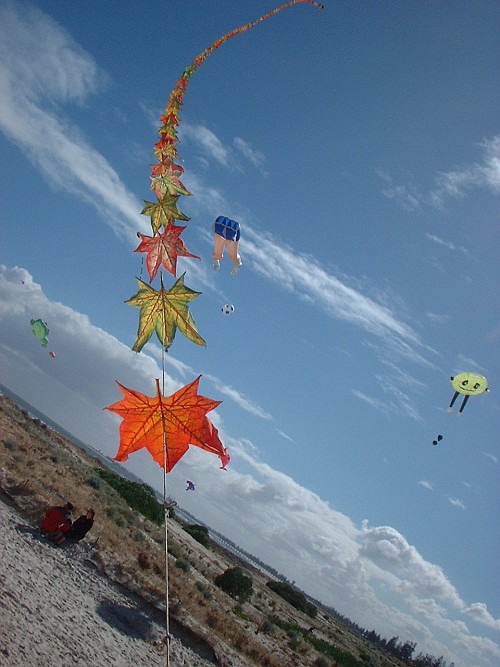- Home Page
- Popular Kites
- ... Kinds Of Kites
Different Kinds of Kites
Illustrated by Kite Festival Photos
As a family, we've seen many different kinds of kites simply by turning up to a large kite festival for several years running.
With a site like ours, we would have been silly not to take a digital camera and capture all the highlights!
The photo below features a self-launching diamond-kite arch. Most of the other kites are inflatables, but there's a Cody box kite aloft as well. Plus look for a black-and-white keelless delta, another delta with duck feet trailing behind (!), and a seagull flying downwind.
I count at least six different kinds of kites in the photo. How many can you spot? For example: inflatable, box, diamond, and sled.
Further down this page are closeups of a fantastically varied collection of wonderful, colorful kites.
On this site, there's more kite-making info than you can poke a stick at. :-)
Want to know the most convenient way of using it all?
The Big MBK E-book Bundle is a collection of downloads—printable PDF files which provide step-by-step instructions for many kites large and small.
Every kite in every MBK series.
Different Kinds of Kites: Pics & Facts
These kite categories are listed in roughly the order you might expect to notice them at a typical big kite-festival. However, I'm a little biased toward single-line designs, so the multi-line kites are shuffled down to the bottom. ;-)
Inflatables
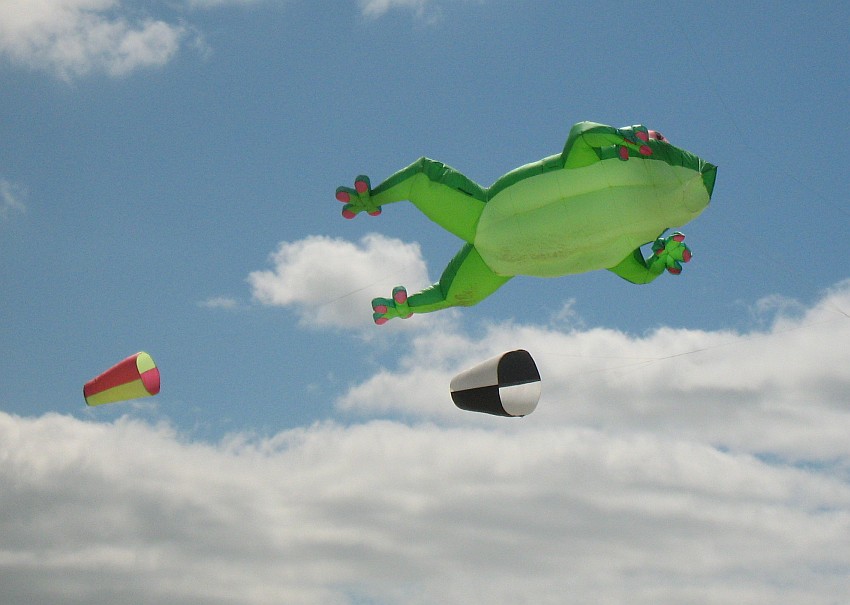
Invariably, when approaching a kite festival, the first thing you spot is a giant inflatable! They really make an impression, and it's not just the size.
Ingeniously crafted from large numbers of nylon or polyester panels, these kites are most often inspired by sea creatures. However, we thought that a giant frog was eye-catching!
This kind of kite inflates from the front via air intakes that are carefully designed to blend with the overall structure.
With the 100s of hours put into constructing these creations, it's not surprising that they can cost quite a bit. Think in the thousands of dollars! Kite-festival organizers are well aware of the crowd-pleasing qualities of these huge kites. Inflatables are probably the most spectacular things in the air at most modern Western kite-festivals. And that is not to mention an increasing number of similar festivals across Asia that mix large traditional kites with more modern designs from East and West.
Parafoils
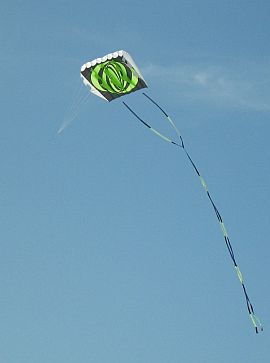
These are single-line parafoils, not the multi-line kind flown as stunt or traction kites. See further down this page for those!
The largest of these parafoils are great for lifting other things into the air—like wind socks, spinners, and banners. At a kite festival, the very biggest kites in any given category are likely to be on show, and these single-liners are no exception.
Parafoils are characterized by an upper and lower surface, divided into cells by vertical ribs. The cells have openings facing the breeze to keep the large kite pressurized and semi-rigid.
Sometimes, many bridle lines and keels are necessary to help keep the shape flat and rectangular in the air. In fact, parafoils are really a category all on their own, with many different kinds of kites of this general type visible at a typical festival.
The reason these kites are so often used to hoist other things attached to their flying lines is their higher line-tensions compared to other kinds of kites of similar size. This is particularly true when the wind strength gets up a bit! A heavy-duty parafoil will still be up there long after more delicate kites have been taken down by their worried owners.
Not every workhorse parafoil is plain looking. All that sail area still lends itself to some nice graphics! We've seen plenty of quite attractive parafoils at the local kite festival. See the kite in the picture up there.
Deltas
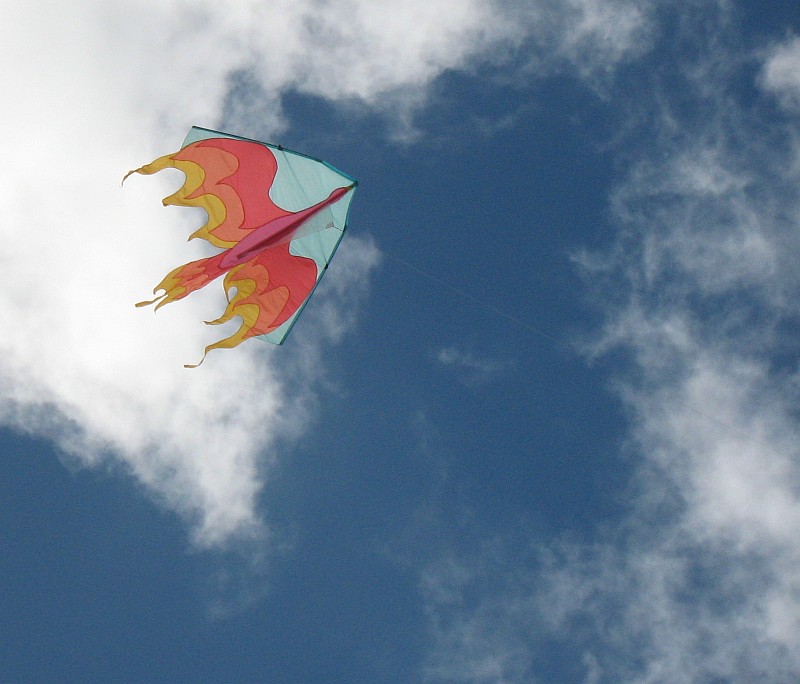
Ah, deltas! Who hasn't seen one of these, floating gracefully in light winds at ridiculously high line-angles.
Is it a bird? Is it a plane? No, it's a large delta, most likely constructed from fiberglass rods or tubes and light-but-strong ripstop-nylon cloth.
The most basic delta configuration is a plain triangular shape with a simple triangular keel and no tail.
There are plenty of different kinds of kites in the delta category. These range in size from small children's toys right through to quite large and artistically-decorated designs that can be spotted in the higher reaches of the kite cloud at a festival.
The photo up there shows a mid-sized design with some clever variations on the basic delta planform. A "Phoenix" is incorporated via both the graphics and the trailing edge outline of the kite sail.
The larger deltas rarely need tails to fly properly, but of course they look more spectacular with a well-designed matching tail flowing out the back!
Rokkakus
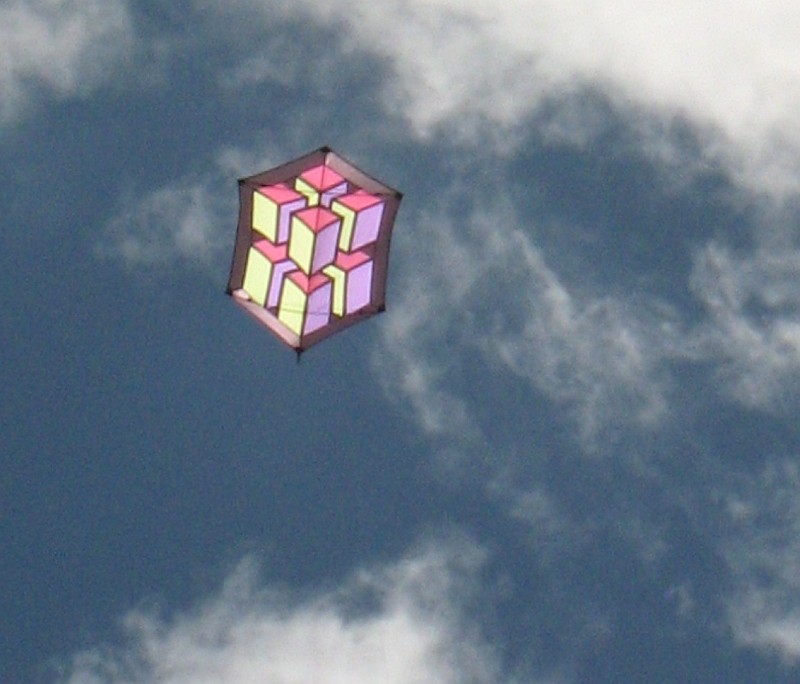
In terms of flying performance, these kites can give the deltas a run for their money. On top of that, they do tend to be more stable and reliable than deltas! This becomes more noticeable as the wind strength approaches the maximum for the kite.
Like any decent delta, a good rokkaku doesn't need any tail. In fact, tails just make these kites fly at slightly lower line-angles.
Roks, as they are commonly known, originated in Japan but have been enthusiastically taken up in the West as well. The symmetrical sail is wonderfully suited to playing the role of an artist's canvas. Check out the fake-3D pattern painted onto the large rokkaku in the photo!
On one occasion we were fortunate enough to see a bunch of genuine large Japanese rokkakus at the festival. The bold, artistic designs were stunning, and we got some great photos. For some reason, owners of large roks are less inclined to attach long tails to their kites as decoration.
Down the bottom of this page is a movie of a rokkaku battle between a number of small white roks. The last kite in the air wins, with pilots trying to saw through each others lines! Each rok was identified by a painted Japanese numeral. As you can tell by the background, the contest was part of a major kite festival.
Cellulars
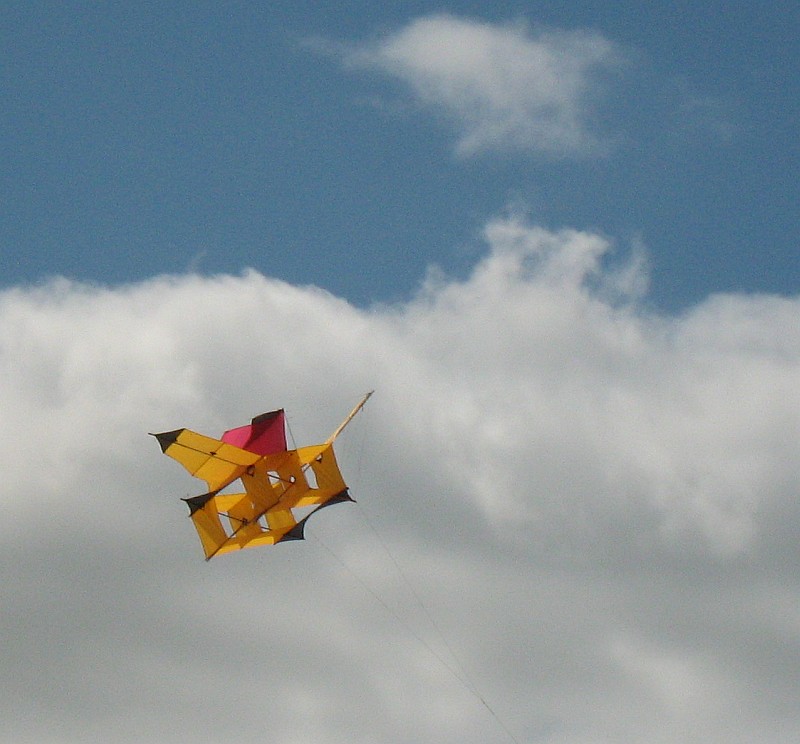
Now, I've chosen to show a fine example of a modern Cody kite here that is basically a double-box kite with wings. It's origins actually go back to the late 1800s as an observation platform for military use.
All kinds of box kites are technically cellulars, since there is usually one or more closed cells at the front of the kite and a similar arrangement at the back. For example, take the simple traditional box kite...
The traditional box has a single cell of rectangular panels at the front and another identical one at the back. Most people can imagine what this kite looks like, because boxes have been used in illustrations almost as much as the very well-known diamond!
In addition to kites that are clearly based on the traditional box design, there are others which are ... well ... just plain weird and wonderful! Some designers have gone to great lengths to construct amazing, complex designs that utilize individual flying cells of some kind.
Sometimes the cells aren't even straight-sided. The variations are so great that you can't actually post a picture of a "typical cellular kite." There are just too many different kinds of kites in this category. The Cody up there doesn't even hint at what some of these cellular kites look like! If you're curious, just look up the pages on box kites on this site.
Diamonds
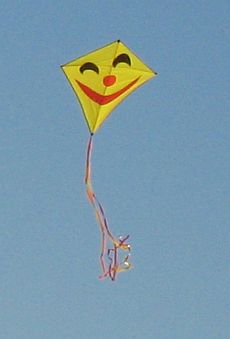
This, of course, is the most recognizable kite shape in the Western world. This example stood out from the crowd due to its bright-yellow color and fun design!
Diamonds are easy to make. They are very reliable when flown with an appropriate length of tail and perform well—not spectacularly well like an expensive large delta but well enough for your average weekend kite-fancier or child flier.
The popularity of the diamond kite has had some ups and downs (sorry!) over the centuries. Currently, its dominance is challenged by the huge variety of easy-to-fly alternatives that are pushed out by the modern multi-million-kite industry.
But the humble diamond doesn't look like dying just yet. A great variety of good-looking designs are available at retail outlets both on and offline.
Sizes range from tiny through to mid-sized. I had never seen a truly large diamond at the local kite festival, so I took my Multi-Dowel Diamond there one year! At 2.4 meters (8 feet) across, I'm sure it is larger than 98 percent of diamonds that are flown anywhere. Perhaps most "serious" kite fliers disdain the common diamond! They do seem to prefer different kinds of kites, such as big deltas and rokkakus.
Sleds
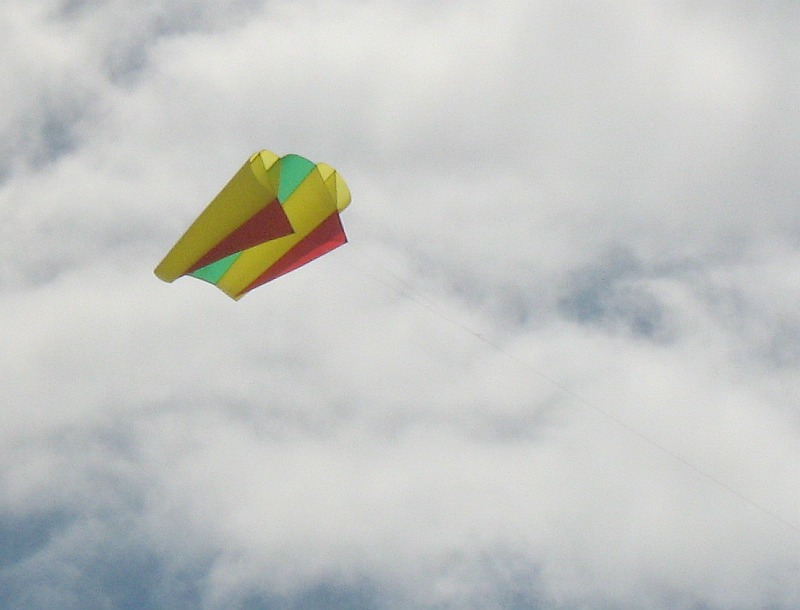
This style of kite has always been of modest size and mainly for child fliers.
To sum up the basic concept, these kites are single-surface with two and sometimes more vertical spars that help to keep the kite's shape in the air.
These days, the spars are often the inflatable variety instead of rigid sticks.
See the photo, where the kite has its two spars inflated by the wind. There's one on each side. This has the advantage of letting you squash the kite up into a very small space for transport. In fact, one small design was called the Pocket Kite for this reason!
Sleds are very convenient to fly, having almost zero setup time. Just unroll or unwrap, let the air fill it, and away it goes! We have seen many different kinds of kites that are basically sleds at the kite festivals we have attended. At the top end of the size range, sleds can be attractive and reliable fliers that can cope with a rather large range of wind speeds. Now that's handy at times, for avoiding disappointment!
Novelty
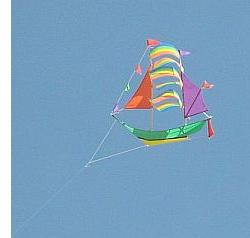
Like the cellular kites discussed earlier, it's impossible to select a "typical" novelty kite that represents them all.
Novelty kites are often rather small, often humorous in concept, and are generally designed to catch the eye of the very youngest kite-fliers out there!
The ship kite pictured seemed to fly quite stable in a moderate breeze. I've seen a few different kinds of kites that are even funnier.
But this little ship was definitely an attempt at humor. After all, ships aren't supposed to fly!
If a novelty kite flies at all, that's good enough. Most of the ones we saw flew at very modest line angles, but I doubt that was of much concern to their owners! A funny kite bobbing about several meters off the ground makes the kid happy, and this tends to make the parents happy too.
These kites are based on just about any common object, creature, or machine imaginable. The more ridiculous the idea of one of these things flying in the air, the better! Sometimes it's the motion of the kite that tickles your funny bone—like a little red bat kite we once saw. It flapped as it flew, and the thing was just pathetic as a kite—but it sure made me smile at the time.
Come to think of it, it's probably just as well that there is such variety available in the different kinds of kites in the novelty category. As with cartoons, different people can have very different preferences!
Traditional
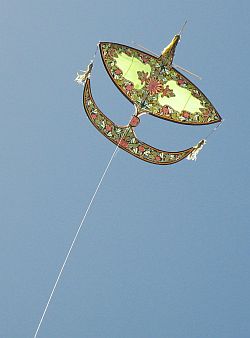
This is another very broad category, due to the fact it includes any kite made from natural materials from a non-Western culture.
We saw just a few examples of different kinds of kites made in a way that hasn't changed in many decades and possibly centuries. A rather special one was the Wau Bulan from Malaysia...
This Wau kite was an impressive size, and I was pleased to capture several closeup images of it in flight. The decoration, as you can see in the photo, was truly eye-catching and intricate. Not only did it look great, but this kite flew at very high line-angles. It wasn't to be outdone by all the hi-tech deltas and roks flying on that same day!
Of course, dozens of different kinds of kites in traditional styles are to be seen at festivals across Asia and Australasia. To name just a very few regions that have interesting kite cultures, there is Bali, Thailand, Taiwan, Korea, Japan, China, and New Zealand.
Stunt
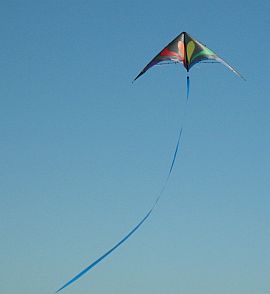
Stunt kites occupy a whole world of their own that is distinct from single-liners, in that two or more lines allow very direct steering control of the kite.
These kites go just where you tell them to—at least when you've become a good enough pilot!
Despite flying much lower than most of the single-liners at a kite festival, the stunters are certainly very eye-catching due to their constant swirling motion. This is not to mention the modern trend toward super-bright and bold color-schemes!
The photo shows a typical large delta stunt kite. Although more complex than a single-line delta, these steerable kites do share some similarities in appearance. This is obvious from a quick glance. The long tails on these kites are purely for effect, tracing out the kite's every move through the air.
Also carving up the air on the day were a number of flexible stunters, which are rather different kinds of kites to the two-line deltas. These look a little like those rectangular sport parachutes that skydivers use. These "soft" kites are controlled with two lines just like the delta stunters but have somewhat different flying characteristics. For example, you have to move your arms more to get the kite to turn tight, and the pull on the lines is greater than for a similar-sized delta.
Traction
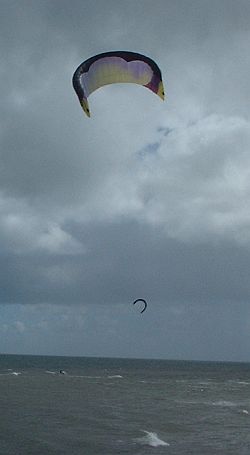
I guess there are a lot of big kite-festivals that are held a long way from the nearest ocean. However, here in Adelaide, the Southern Ocean is lapping the beach while the kite festival is in progress. Hence, kite surfing is a feature.
The further down the jetty you go, the better the view is of these surfer dudes skimming across the water and often launching themselves into the air...
Their kites are big and powerful, requiring considerable skill to stay in control with fresh winds blowing. It all gets a bit sedate if the winds aren't strong enough. The day that photo over there was taken, conditions were reasonable for these guys.
The design of these surfing kites has changed quite a bit, with several different kinds of kites appearing on the market over several decades. A good traction kite for use over water must of course be easily relaunchable from water.
Some designs can fly in a very wide range of wind speeds, obviating the need to own several kites to suit all conditions.
Although kite surfing on the ocean is the most common and well-known use for traction kites, kite-boarding on land is popular too. All-terrain boards or three-wheel buggies are popular choices for getting around on sand, dirt, or grass under kite power.
My wife took the photo below that captures the ever-ascending spectacle of a long kite "train" quite nicely. From a distance, the individual kites looked so realistic.
Closeup, the construction method of crossed bamboo-slivers over tissue was revealed.
Interestingly, the flying line was not the usual nylon or Dacron. Instead, it was quite thick and was formed from a more traditional natural material.
We saw a couple of these long trains on the day, both from Taiwan.
At the festival, I shot some video of a rok battle. Some contestants took it quite seriously, racing around and tripping over in the sand—while attempting to snap their opponents' flying lines! In the background, many different kinds of kites are holding steady in the breeze. Turn up the audio too, since the commentator calls the entire bout:
As mentioned earlier, there's more kite making on this site than you can poke a stick at. :-)
Want to know the most convenient way of using it all?
The Big MBK E-book Bundle is a collection of downloads—printable PDF files that provide step-by-step instructions for many kites large and small.
That's every kite in every MBK series.


